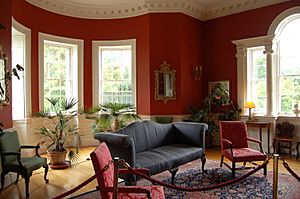Belvedere House and Gardens facts for kids
Quick facts for kids Belvedere House and Gardens |
|
|---|---|
 
The exterior, and the Drawing Room
|
|
| Type | Country house |
| Location | Mullingar, County Westmeath, Ireland |
| Area | 160 acres (65 ha) |
| Built | 1740 |
| Architect | Richard Cassels |
| Architectural style(s) | Palladian |
| Owner |
|
Belvedere House and Gardens is a beautiful old country house in Ireland. It's about 8 kilometers from Mullingar in County Westmeath, right by the north-east side of Lough Ennell. The house was built in 1740. It was first a hunting lodge for a man named Robert Rochfort, 1st Earl of Belvedere. A famous architect from Ireland, Richard Cassels, designed it in a style called Palladian.
Belvedere House is special because of its unique windows and the lovely terraces added in the 1800s. When Robert Rochfort decided to live there permanently, he hired a French artist, Barthelemij Cramillion, to create amazing plasterwork on the ceilings. The large estate also has the biggest "folly" (a building just for decoration) and "spite wall" in Ireland. This is called The Jealous Wall. Robert built it to block the view of his brother's house nearby, after they had a big disagreement. There's also a Victorian walled garden and many acres of forest to explore. The house has been fully restored and about 160,000 people visit the grounds every year.
Contents
The Story of Belvedere House
Building the House and the Jealous Wall
Belvedere House was first built by Robert Rochfort as a quiet place to get away. He had a difficult relationship with his brother, Arthur. Later, Robert also had a disagreement with his other brother, George, who lived on a nearby estate called Tudenham. Because of this argument, Robert built a very tall wall, known as The Jealous Wall. This wall was designed to block his view of George's house.
Changes Over the Years
After Robert Rochfort passed away in 1774, his son, George Augustus Rochfort, became the owner. George Augustus was involved in local politics for a while. He moved to England in 1798 and died in 1814.
When George Augustus's widow died in 1828, Belvedere House went to her grandson, Brinsley Butler, who was the 4th Earl of Lanesborough. He didn't visit Belvedere very often.
In 1847, the estate was inherited by Brinsley's cousin, Charles Brinsley Marlay. Charles moved into the house and made some important changes. He updated the special windows on the upper part of the house and added the beautiful terracing you see today. He also hired an expert, Ninian Niven, to design the Victorian walled garden.
Restoration and Public Opening
After the Second World War, a soldier and mountaineer named Charles Howard-Bury took on the task of restoring the house and gardens. He worked hard to bring them back to life.
When Charles Howard-Bury passed away in 1963, his friend Rex Beaumont inherited the estate. Rex sold Belvedere House to Westmeath County Council in 1982. After that, a huge project began to restore the house and gardens. Millions of pounds were spent to make it beautiful again.
Today, Belvedere House and Gardens are open for everyone to visit and enjoy. It's a popular spot for weekend music festivals and outdoor theater shows.
Gallery





